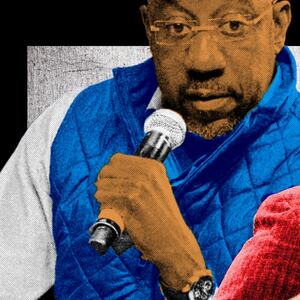Left in the wake of the countervailing forces that made the 2022 midterms so unusual are 18 GOP House seats set to become the new battleground in 2024.
And as if New York didn’t have enough influence over the country, a handful of flipped seats there could once again make the difference between Democratic and Republican control of the House.
Known as crossover seats, what these 18 all have in common is a Republican victor who prevailed in a district that President Joe Biden won in 2020. On the Democratic side, there are five members who pulled off a victory in a district former President Donald Trump carried in his 2020 defeat.
ADVERTISEMENT
What’s especially notable about the most extreme crossover seats in the GOP column is their concentration in a handful of blue states—particularly New York and California.
Veteran New York pollster Steven Greenberg of Siena College emphasized that there are too many variables at the top of the ticket to make any kind of a forecast this far ahead of the 2024 election, but the GOP will have several historical factors going against them in a presidential election year compared to a midterm one.
“Clearly there were Democrats and independents who flipped and voted Republican—at the state level, at the congressional, at the legislative level,” Greenberg told The Daily Beast.
Managing to pick up four House seats will either be the exact majority for the party or one shy of it. It’s an even more surprising outcome in a year when Republicans were favored far more nationally than in New York, where they initially seemed doomed by redistricting.
The results took even the most seasoned Empire State political observers by surprise, Greenberg noted, with the earliest warning signs coming just a few weeks before the election.
The electorate in 2024 will likely look much different. While turnout in the nation’s fourth-largest state was high for a midterm by historical standards, it fell below that of 2018 and 2020.
“Twenty-four, in a presidential year, figures, historically, to be a better turnout scenario for Democrats,” Greenberg said. “But, the political world keeps changing, so we are 23 months before that election not knowing for sure who the candidates are going to be either at the presidential level or at the U.S. Senate level, who the Republicans will pick to try and break their New York State streak in a race against Gillibrand.”
Despite a strong showing and a late surge from Republican Rep. Lee Zeldin, the GOP still has yet to win any race statewide since 2002. Still, the outgoing Long Island congressman and his powerful GOP ally, Rep. Elise Stefanik, set a playbook for how Republicans can compete with Democrats in upstate New York and Long Island.
One New York GOP operative told The Daily Beast that they’re still feeling bullish about holding onto the formerly blue turf in 2024.
“New York felt the pain of one-party Democrat rule in Albany and D.C.,” the campaign consultant said, requesting anonymity because they are not authorized to speak on behalf of clients. “Smart members like Elise Stefanik wisely invested time and money in key New York races, essentially securing the majority for Republicans. Good members run races that best represent their district, that’s the key to holding these seats.”
Two Empire State Republicans who dug out wins in otherwise heavily Democratic areas were Reps.-elect Mike Lawler and Anthony D’Esposito.
D’Esposito, a councilman from Hempstead, a sprawling township of just over 750,000 in western Long Island, won the district with the biggest Biden margin from 2020 at nearly 15 points.
Lawler, an assemblyman from Rockland County in the Hudson Valley, ousted Rep. Sean Patrick Maloney, the first sitting chair of the House Democrats’ fundraising arm to lose reelection since 1980.
Greenberg said there is no “generic candidate” the Republicans can try and replicate to flip seats like Lawler and D’Esposito did. Instead, the pollster said it’s better to look at it from a hyper-local point of view, and to account for multiple motivating factors instead of one overriding issue.
“Ultimately, for all the punditry and predictions, voters get to decide and voters get to determine who they want to represent them, and voters get to do things that the pundits don’t necessarily think they’re gonna do,” Greenberg said. “And voters decided, whether it was a reflection on Lee Zeldin or Kathy Hochul or the national attitude or ‘I’m sick and tired of the pandemic after two years’—whatever it was.”
The voters also said something about themselves.
“Caution to the wind,” Greenberg said, “because this is not the way a New York electorate traditionally performs.”







